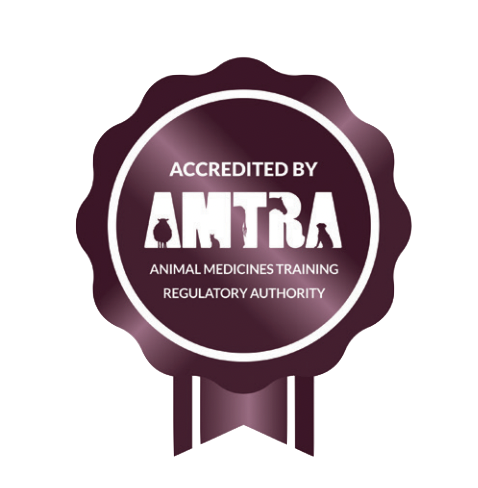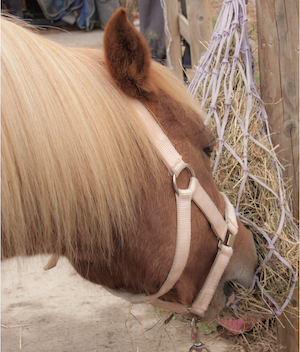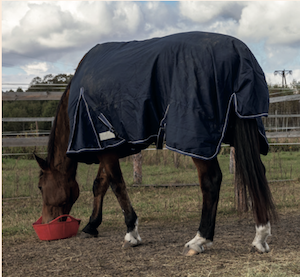
FROM ONE EXTREME TO THE OTHER: Feeding the laminitic and feeding for performance
AMTRA is required by the Veterinary Medicines Regulations to ensure its RAMAs/SQPs undertake CPD. All RAMAs/SQPs must earn a certain number of CPD points in a given period of time in order to retain their qualification. RAMAs/SQPs who read this feature and submit correct answers to the questions below will receive two CPD points. For more about AMTRA and becoming a RAMA/SQP, visit www.amtra.org.uk
Being asked for nutritional advice can feel daunting, especially when you are put on the spot. We asked SPILLERS nutritionist Sarah Nelson for some advice on how to approach two very different situations; a pony in light work with a history of laminitis that is prone to weight gain, and a competition horse prone to non-glandular ulcers and weight loss.
DIET & LAMINITIS
Providing a diet low in non-structural carbohydrates (NSC) or ‘starch and sugar’ and maintaining a healthy body condition are top priorities when it comes to the nutritional management of those prone to laminitis. Recommend customers seek specific advice from a nutritionist, especially in cases of severe insulin dysregulation.
STARCH & SUGAR
Some of the different terms used to describe starch and sugar can lead to confusion. Here’s a quick guide to busting some of the jargon
- Non-structural carbohydrate (NSC) = starch + water soluble carbohydrate.
- Water soluble carbohydrate (WSC) consists mainly of simple sugars such as sucrose and fructan.
- Fructan is the ‘storage’ form of sugar in the majority of UK grasses and consequently hay and haylage.
UK forage contains very little starch but may be high in WSC. Whole cereal grains on the other hand are high in starch but relatively low in sugar.
FORAGE FOR GOOD DOERS PRONE TO LAMINITIS

Ponies are renowned for being grass guzzling machines and have been seen to consume up to 5% of their bodyweight (dry matter) in grass per day when living out 24/7 - this could equate to enough calories to fuel a 500kg racehorse and almost 2kg of simple sugars per day for a 250kg pony!
Hay soaking is common practice for good doers and laminitics. Research has shown both water temperature and the length of soak influences WSC losses, but results are highly variable. Soaking also increases microbial contamination although the implications of this are still not fully understood.
Practical tips for customers
- Restrict or remove grazing. Horses and ponies at very high risk of laminitis may need to be removed from grazing completely.
- Winter grazing and ad lib hay may exceed calorie requirements for good doers and may be deceptively high in WSC or ‘sugar’.
- Ideally feed a hay containing <10-12% NSC.
- Grazing muzzles have been shown to reduce grass intake by an average of 80% regardless of the season. This means they can be used all year round provided the grass is not too long or too short to be accessed through the base of the muzzle. However, some horses and ponies may simply eat more once their muzzle has been removed so consider non- grass turnout or stabling for the remainder of the day. Advise customers seek advice from a nutritionist on how to use a muzzle safely.
- As a guide, recommend owners soak their hay for 1-3 hours in warm weather and 6-12 hours in cold weather but remember this doesn’t guarantee suitability for laminitics. Alternatively consider suggesting a hay replacer low in starch and sugar.
- Due to the loss of nutrients (and therefore dry matter) into the water, each haynet will contain more water and less ‘hay’ post soaking. Recommend owners increase the amount of hay they soak by approximately 20% to compensate (unless feeding ad lib) - this will help to ensure that total forage intake is not restricted too severely.
- Consider replacing up to 30-50% of the forage ration with straw. Any straw fed should be introduced gradually and be of good hygienic quality.
- Total forage intake should not be restricted to less than 1.5% of current bodyweight per day on a dry matter basis. This is equivalent to approximately 5.5kg of hay (or 6kg if it is to be soaked before feeding) for a 300kg pony without access to grazing on an ‘as fed’ basis.
CUT CALORIES NOT NUTRIENTS
While forage can easily exceed the horse or pony’s energy (calorie) requirements, forage only diets may be lacking in key nutrients including copper, zinc, vitamin E and the essential amino lysine. Balancers are the ideal way to provide essential vitamins, minerals and amino acids (quality protein), while adding minimal amounts of energy, starch and sugar to the total diet.
Practical tips for customers
- Balancers labelled as ‘Lite’ are not significantly lower in calories than alternative options (exception of stud balancers) – look for products that offer additional benefits for horses on calorie restricted diets such as high levels of lysine and vitamin E. Some balancers also contain functional ingredients to help support a healthy metabolism.
- Feeds for good doers and laminitics do not necessarily need to be molasses free.
- Don’t choose feeds based on percentages alone – remember the amount of starch & sugar (and other nutrient for that matter) consumed from any feed will depend on how much of it is eaten!
EQUINE GASTRIC ULCER SYNDROME (EGUS)
It has been estimated that approximately 90% of racehorses, 60% of competition horses and up to 50% of leisure horses may have gastric ulcers. Several risk factors have been identified including:
- High starch, low forage diets
- Feeding straw as the sole forage source
- Intensive exercise
- Stress including weaning
- Prolonged stabling and travelling
- Use of non-steroidal anti-inflammatory drugs (NSAIDs) such as ‘bute’
If customers suspect their horse has gastric ulcers, advise them to get a confirmed veterinary diagnosis as medication may be needed. It’s also important to establish the location of the ulcers as glandular ulcers may be less responsive to medication and changes in diet.
FORAGE FOR PERFORMANCE & EGUS
Forage should be the foundation of every horse’s diet and the competition/ performance horse is certainly no exception to the rule. The fibre provided by forage is essential for maintaining digestive health and accounts for a significant portion of the horse’s energy (calorie) intake. Saliva, which is only produced when the horse chews, provides a natural buffer to stomach acid which means long fibre (grass, hay and haylage), plays a key role in supporting gastric health. In fact, one study found periods of 6 hours or more without forage significantly increased the risk of gastric ulcers.
Despite common misconceptions, haylage is not automatically higher in energy or protein (or other nutrients) than hay. While certain grass species such as rye grass and less mature (earlier cut) forages generally tend to be higher in calories, there are no guarantees! Regardless of visual appearance, maturity or grass species, the only reliable way to assess the nutrient content of your forage is to have it analysed.
All forage should be of good hygienic quality for all horses, but respiratory health may be of increased concern for competition horses. Multiple studies have found steaming hay in a commercial steamer to be highly effective at improving hygienic quality, but homemade varieties may act as incubator for bacteria.
Practical tips for customers
- Forage should be fed ad lib. If voluntary intake is a concern, suggest customers monitor how much forage their horse is eating by weighing the amount fed and the amount leftover in 24 hours, ideally for 3-5 days.
- Provide forage while travelling.
- Steaming (in a commercial steamer) is the most effective method of improving the hygienic quality of forage. Some horses also find steamed hay more palatable.
- Provide as much turnout as possible – the incidence of gastric ulcers seems lower in horses at pasture.
FEEDS FOR COMPETITION HORSES PRONE TO EGUS
With increased work comes an increase in the horse’s requirement for protein, including the essential amino acid lysine, and the majority of vitamins and minerals. Choosing an appropriate compound feed, fibre feed or even a mash, will supply additional energy for condition, alongside essential amino acids to support muscle development and topline, and vitamins and minerals to support optimum health and performance.
DID YOU KNOW?
Recent research was the first to prove that changes in diet can help to reduce the recurrence of non-glandular gastric ulcers following veterinary treatment?
In this study, horses were paired according to the severity of their gastric ulcers, the type and intensity of their work and their management (including forage intake). One horse from each pair continued with their normal diet whilst the other had their ‘bucket feed’ replaced with a 50:50 ration of two commercially available feeds frequently recommended for horses prone to gastric ulcers’ if needed.
All horses with grade 3 and grade 4 ulcers were treated with the recommended course of omeprazole. Whilst the majority of horses improved as a result of veterinary treatment regardless of their diet, over-all only horses that had their feed changed remained improved six weeks after the treatment had stopped. On the flip side, gastric ulcers scores in the ‘no diet change’ group were overall no better than the pre-treatment scores by the end of the study.
Practical tips for customers

- Choose fibre-based feeds that are low in starch and sugar. Feeds high in oil as opposed to cereal starch are ideal for poor doers – oil is approximately 2.5 times higher in energy compared to cereal grains but starch-free.
- Aim to feed less than 1g of non-structural carbohydrate (NSC: starch + water soluble carbohydrate) per kilogram bodyweight per meal and ideally less 2g NSC per kilogram bodyweight per day. For a 500kg horse this equates to less than 500g of NSC per meal and ideally less than 1kg of NSC per day. Remember 10% is equivalent to 100g per kilo.
- Recommend a balancer for horses that maintain weight well on less than the recommended amount of compound feed or for customers preferring to use feeds without added vitamins and minerals.
- Feed small meals, less than 2kg (dry weight) in total for horses, less for ponies.
- Add short chopped fibre, ideally containing alfalfa, to every meal. The high protein and calcium content in alfalfa is thought to help buffer stomach acid.
- Provide a small chopped, fibre-based meal or access to forage before exercise to reduce gastric splashing.
- Feeds carrying the BETA® Equine Gastric Ulcer Syndrome (EGUS) Certification Mark may bring added reassurance but they are not the only suitable options.
- Ensure all feeds and supplements are BETA® NOPS (naturally occurring prohibited substances) approved.
- Avoid using concentrated electrolyte pastes. In one study, multiple hypertonic electrolyte pastes were seen to significantly increase the number and severity of gastric ulcers.

ABOUT ETN’S RAMA/SQP FEATURES
ETN’s series of CPD features helps RAMAs (Registered Animal Medicines Advisors/SQPs) earn the CPD (continuing professional development) points they need. The features are accredited by AMTRA, and highlight some of the most important subject areas for RAMAs/ SQPs specialising in equine and companion animal medicine.
AMTRA is required by the Veterinary Medicines Regulations to ensure its RAMAs/SQPs undertake CPD. All RAMAs/SQPs must earn a certain number of CPD points in a given period of time in order to retain their qualification. RAMAs/SQPs who read this feature and submit correct answers to the questions below will receive two CPD points. For more about AMTRA and becoming a RAMA/SQP, visit www.amtra.org.uk











